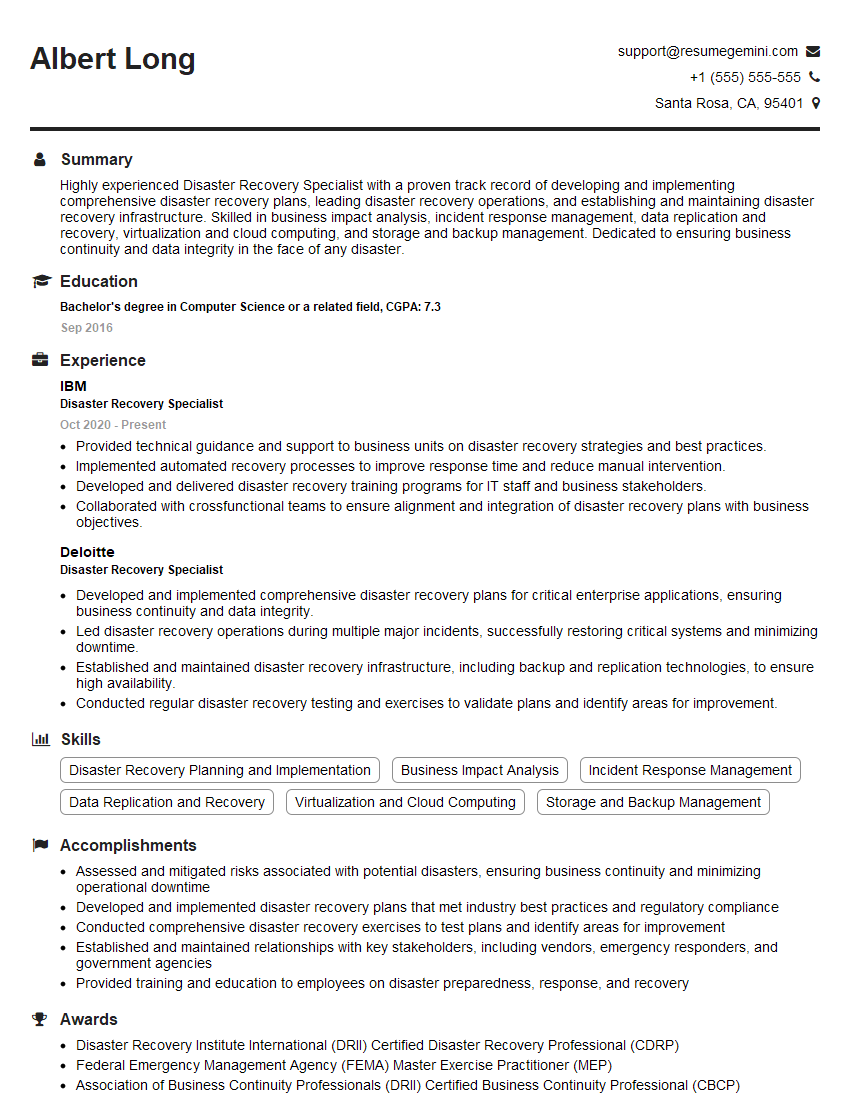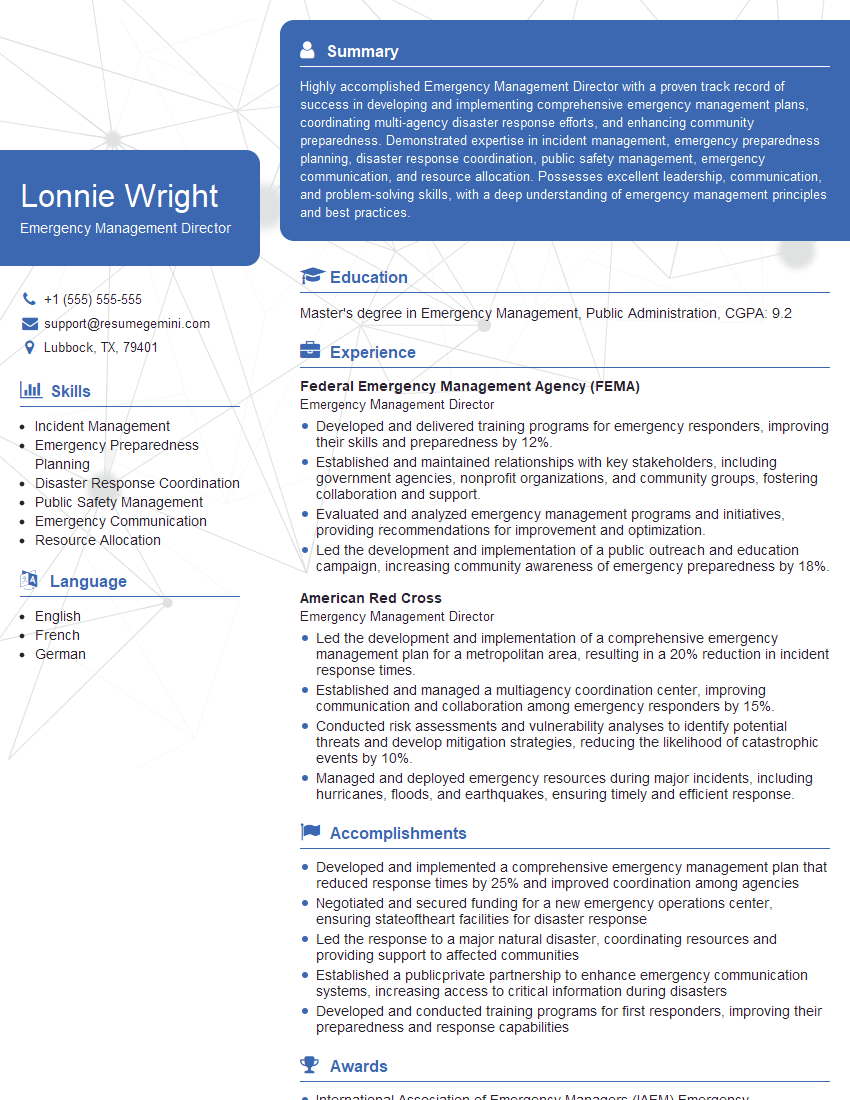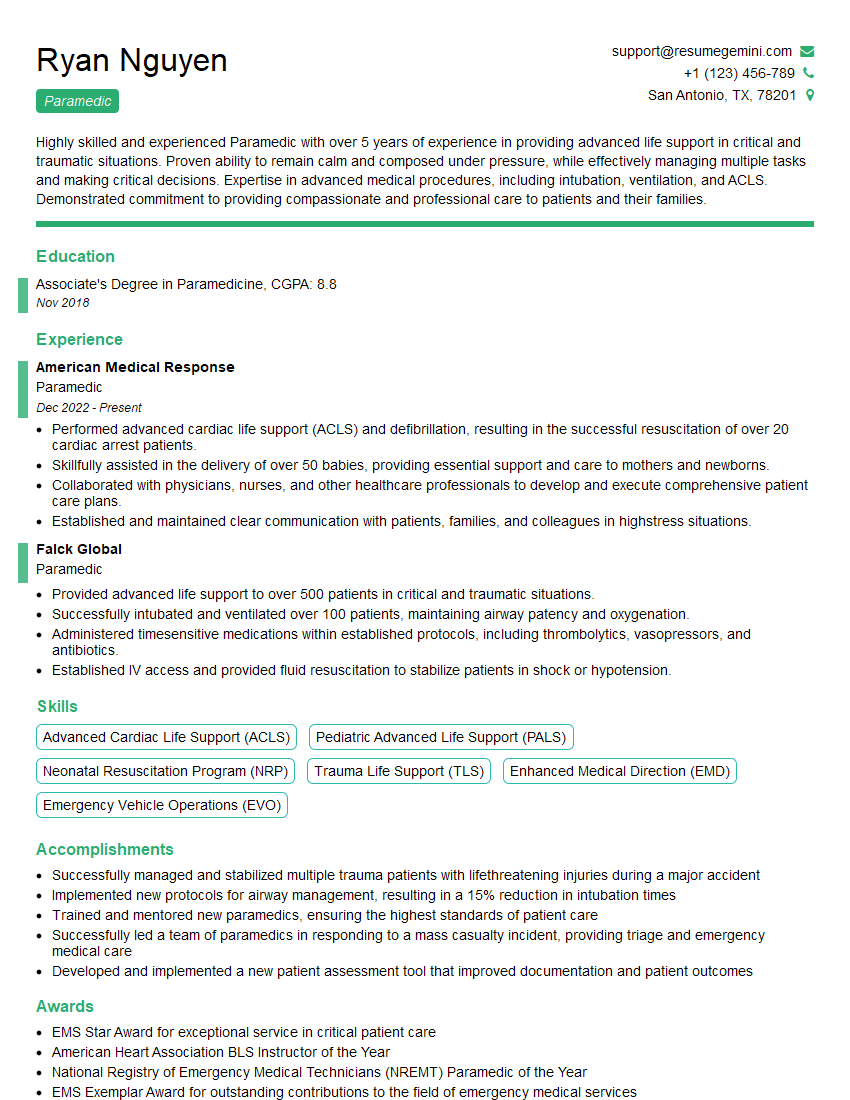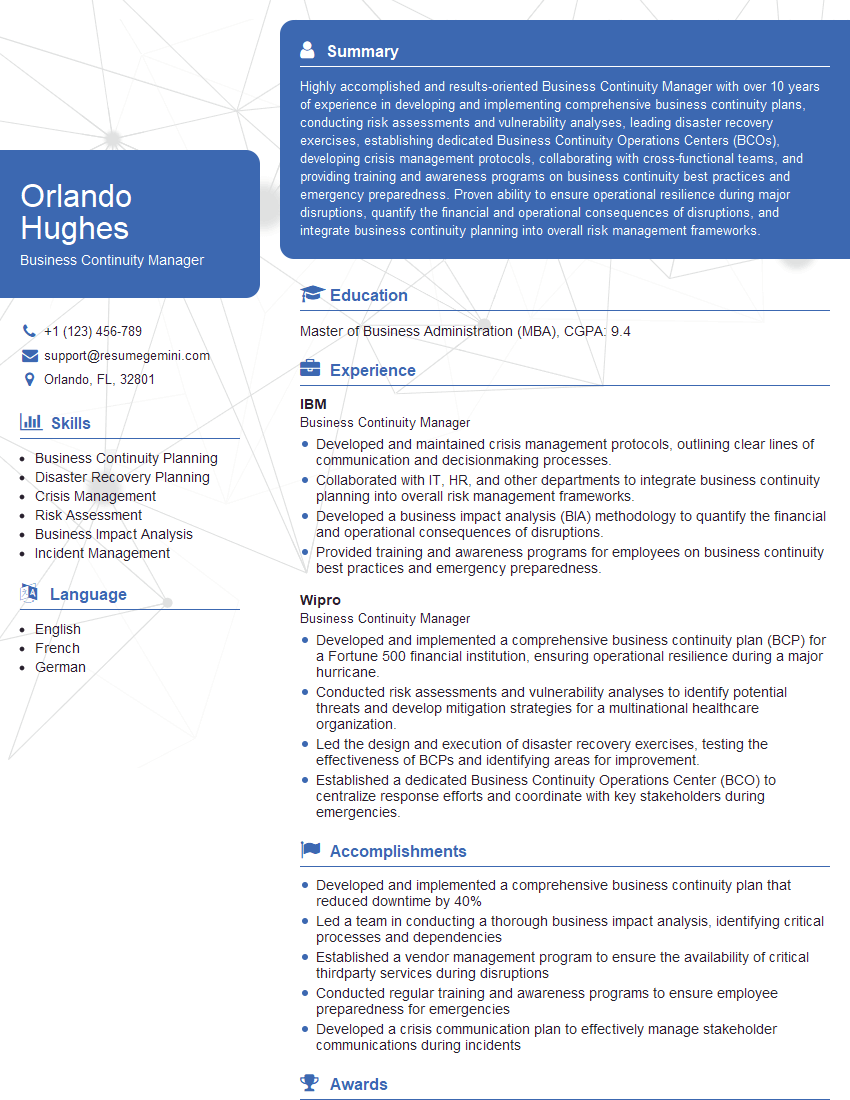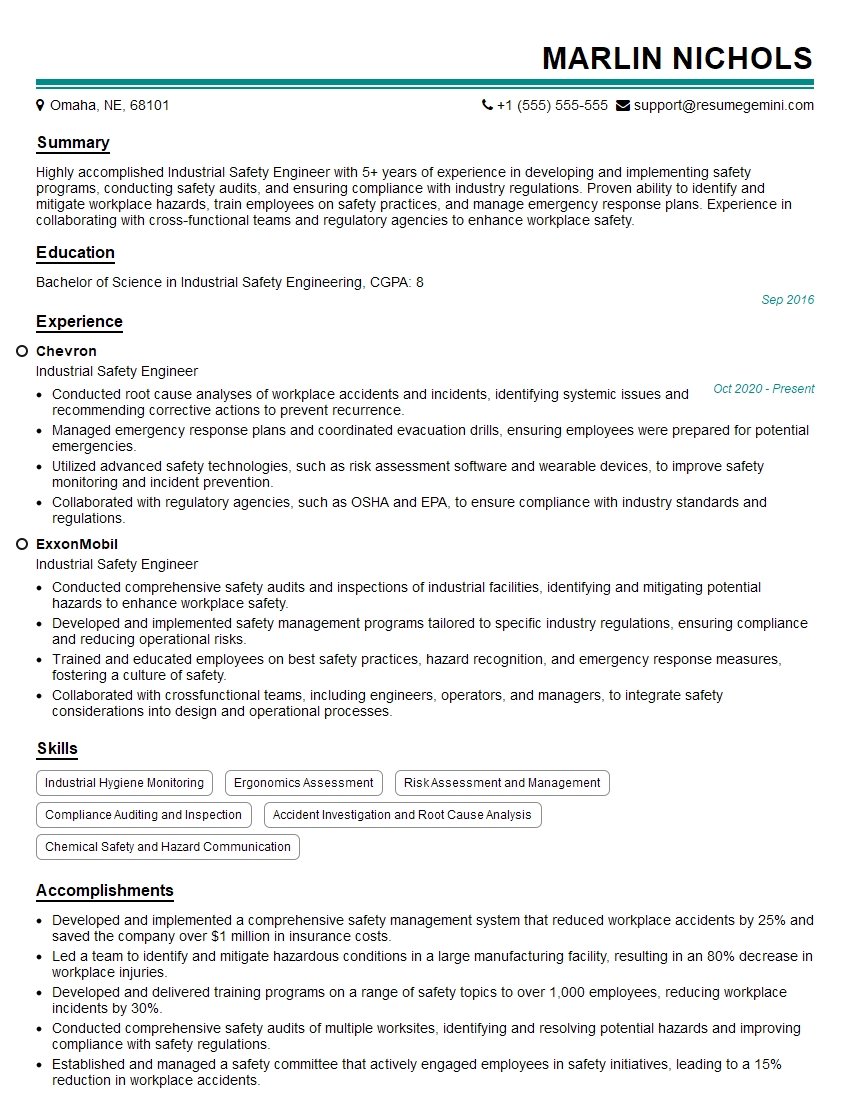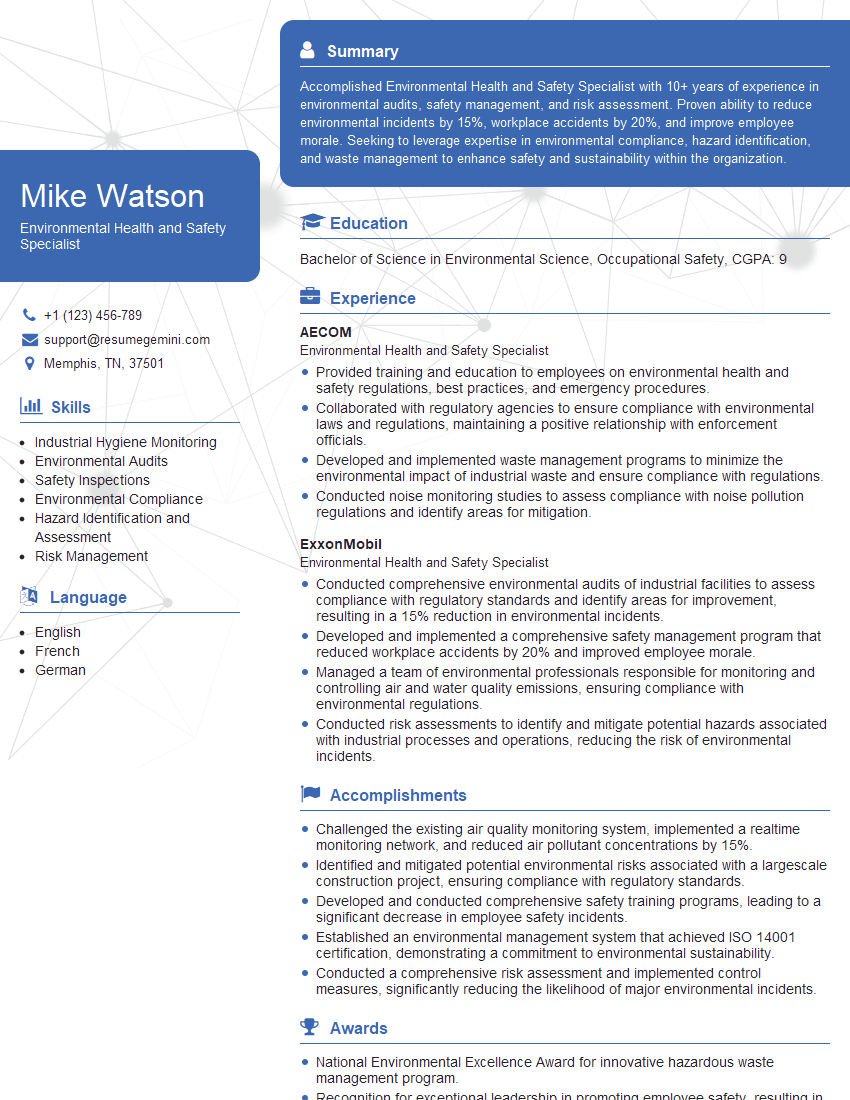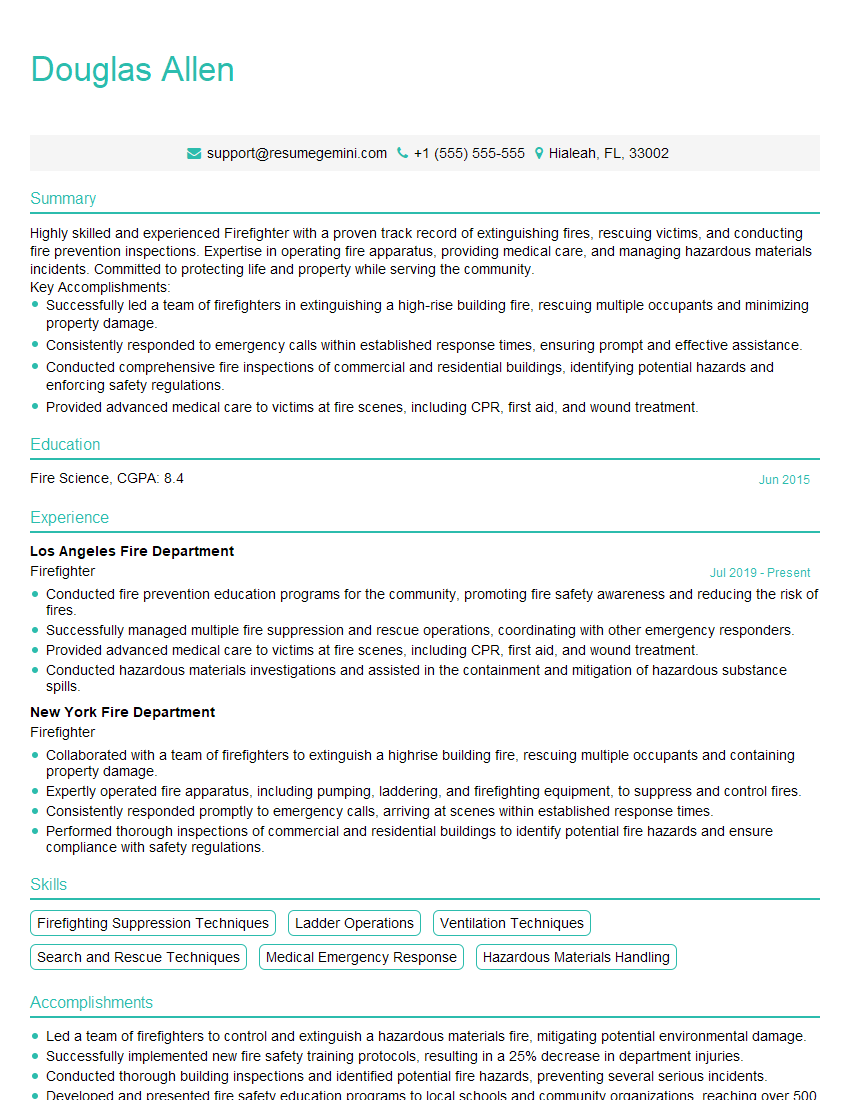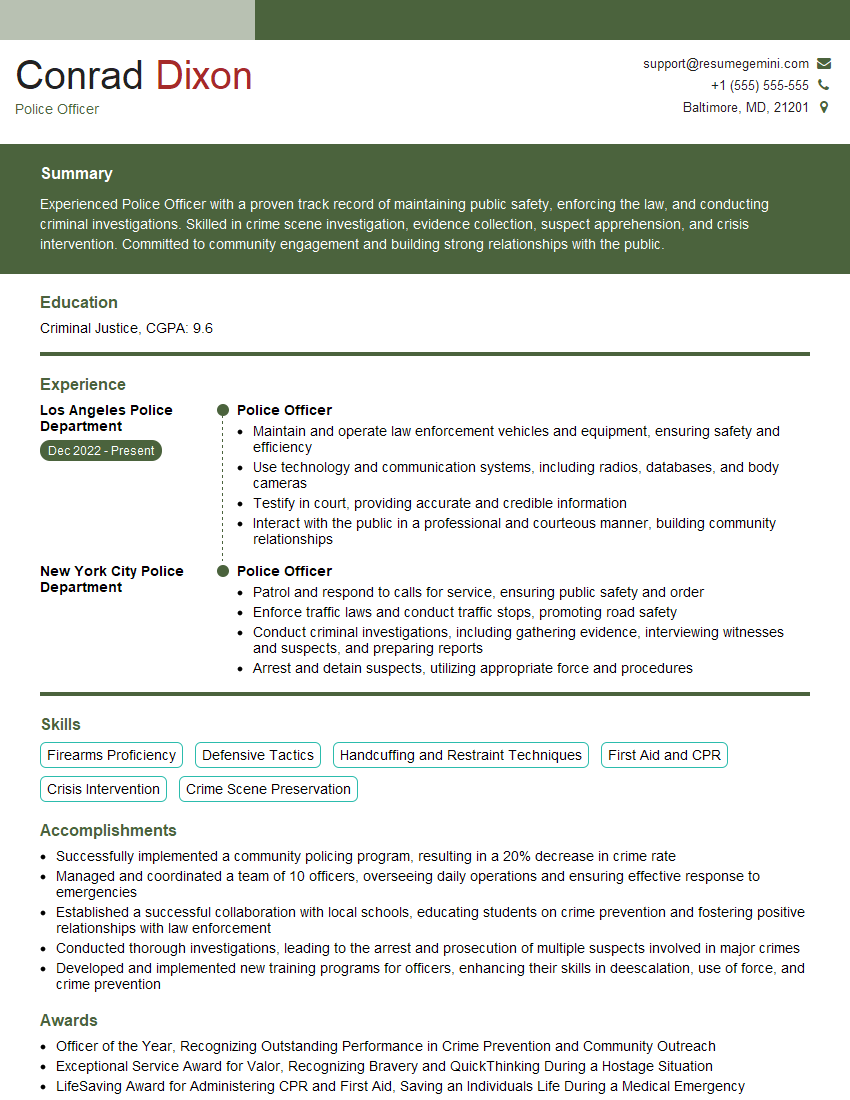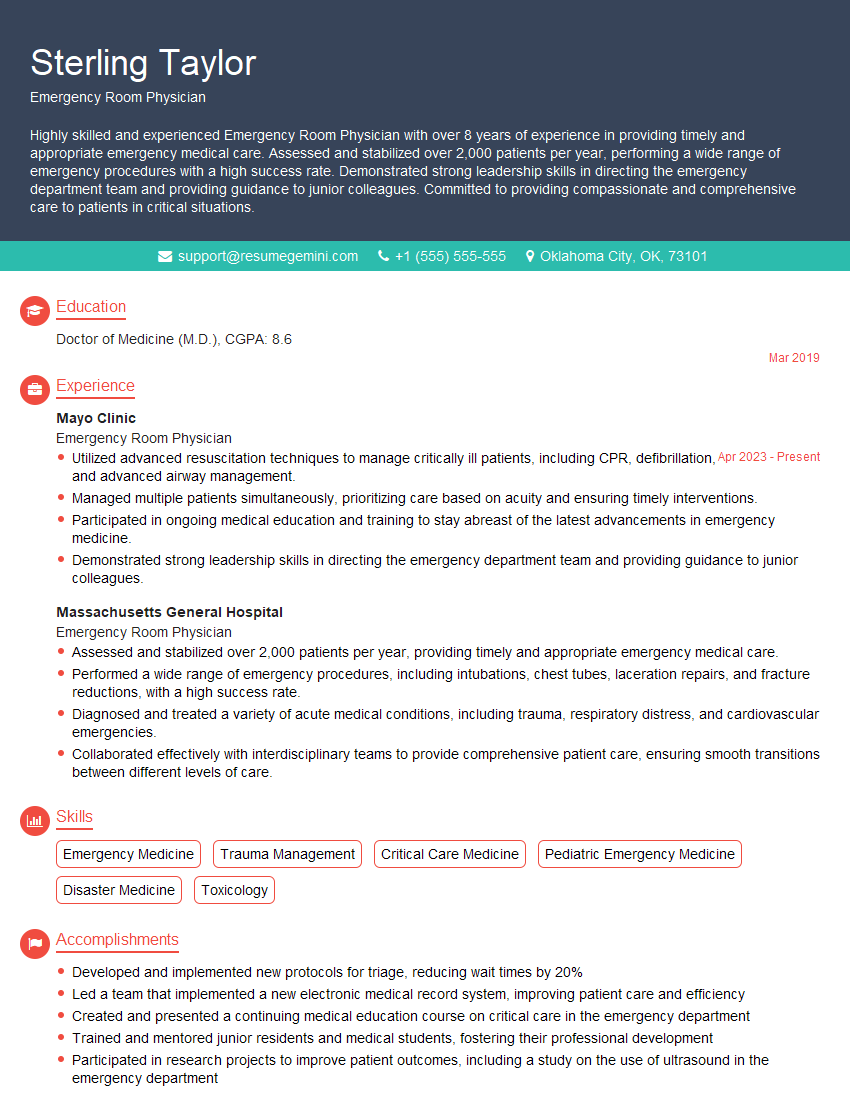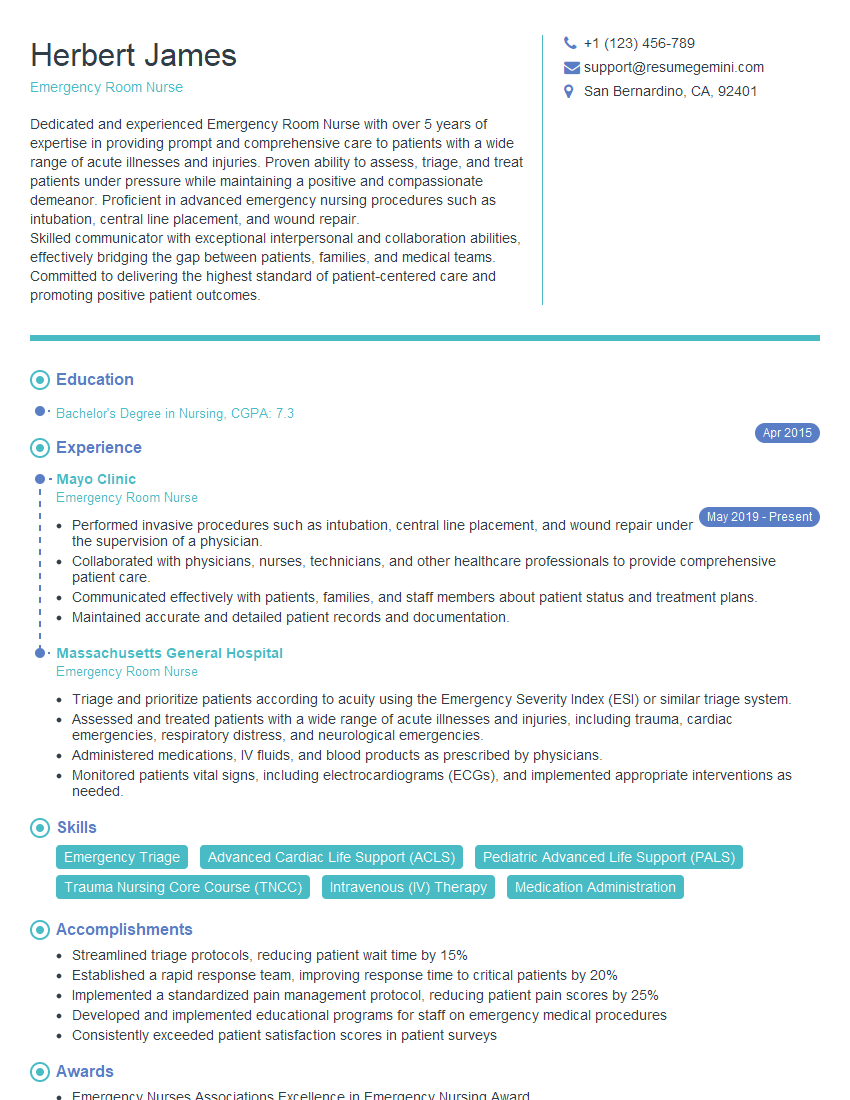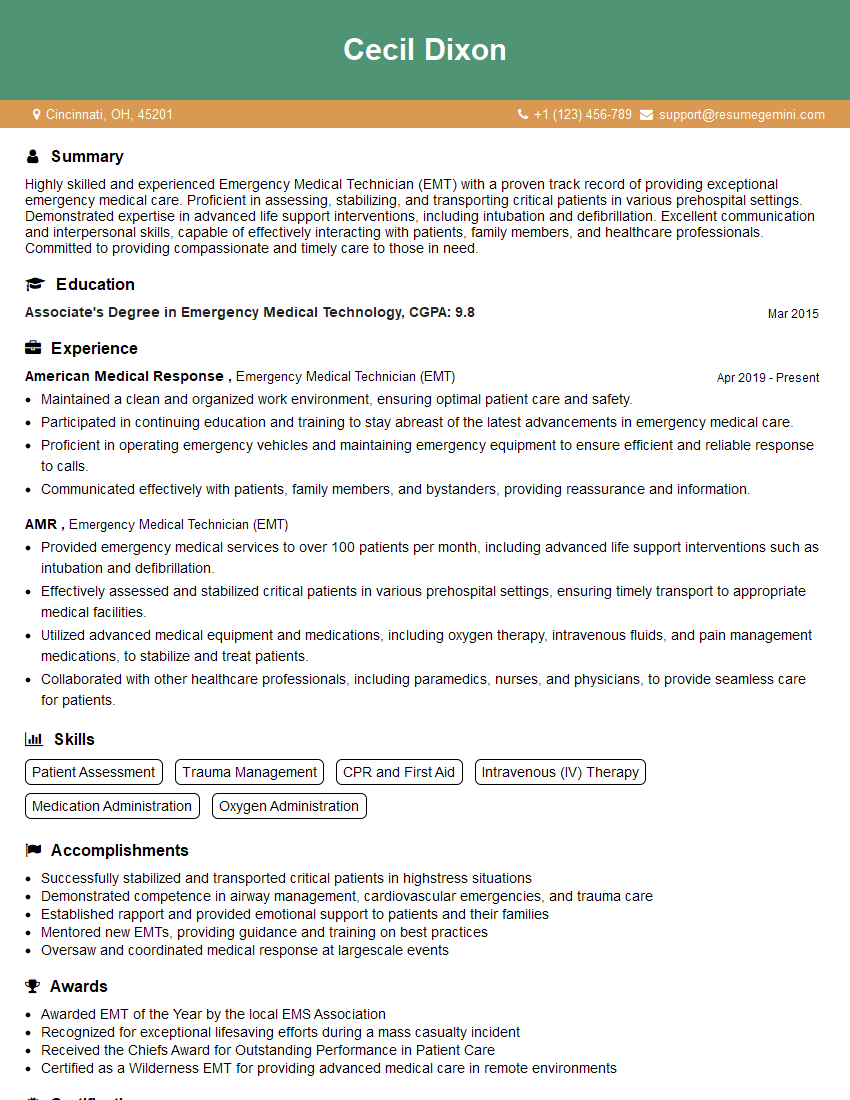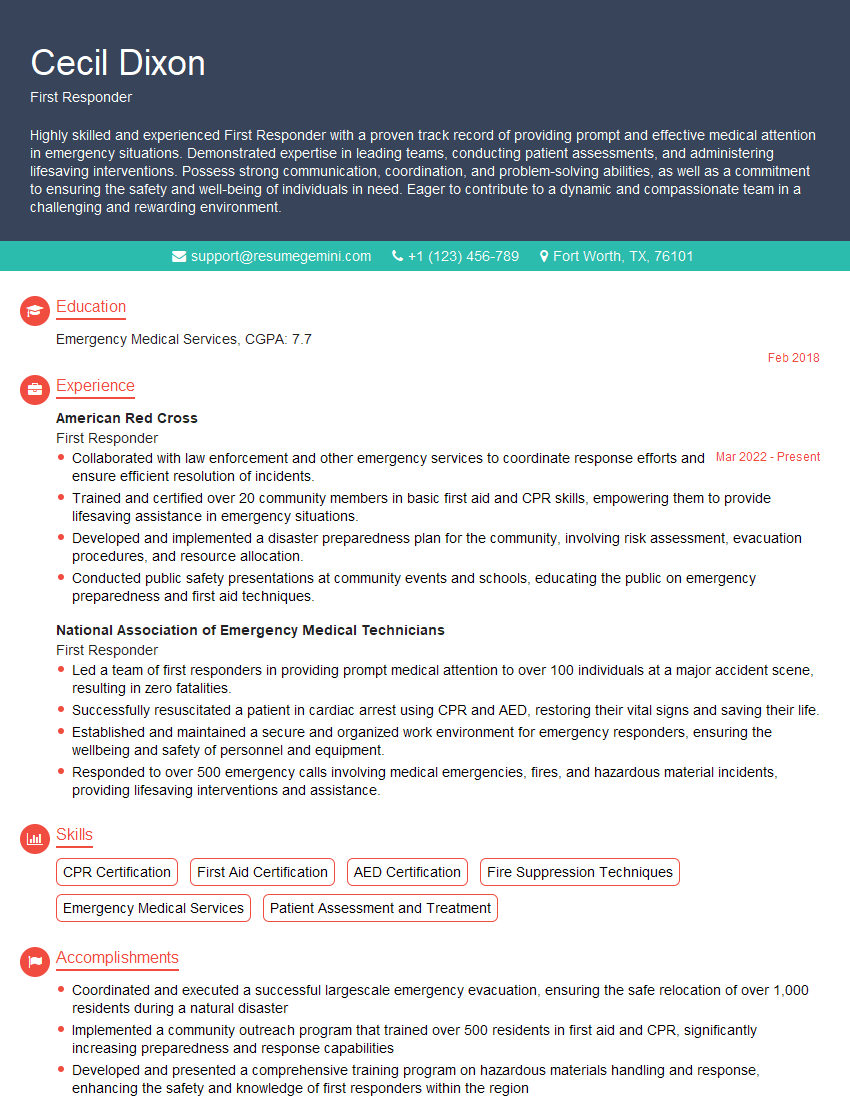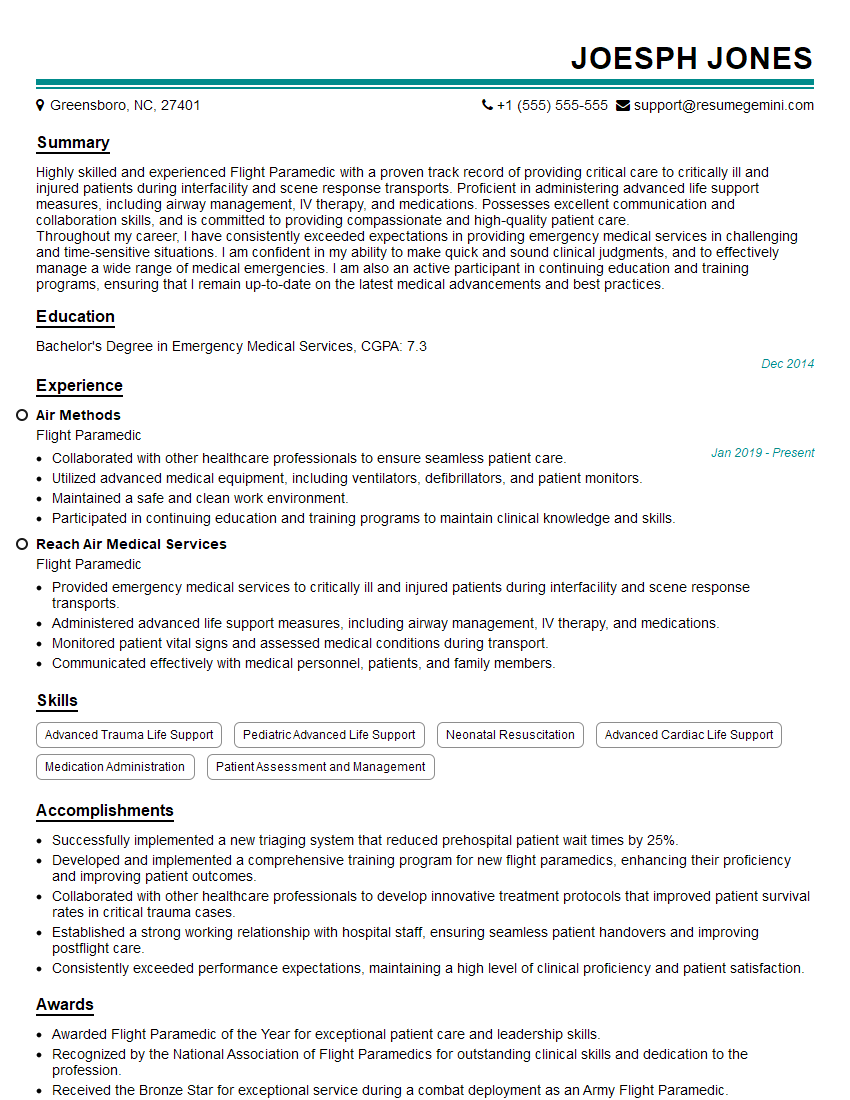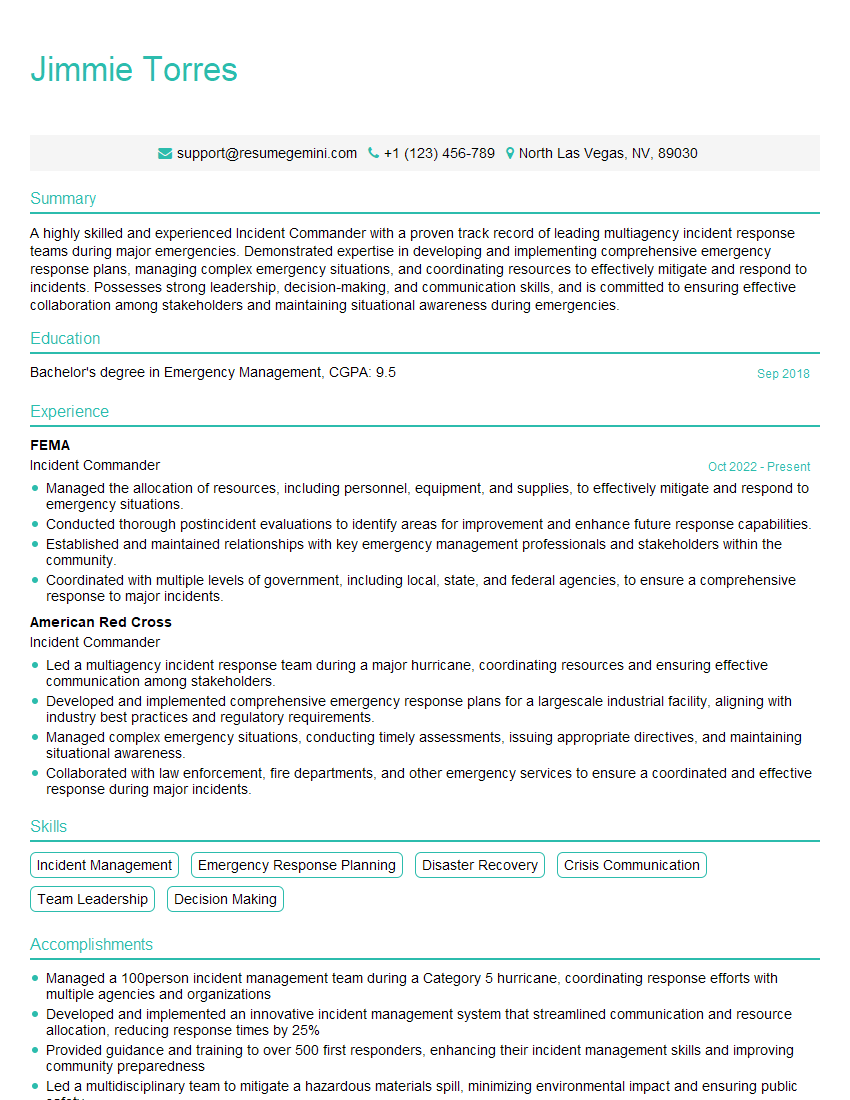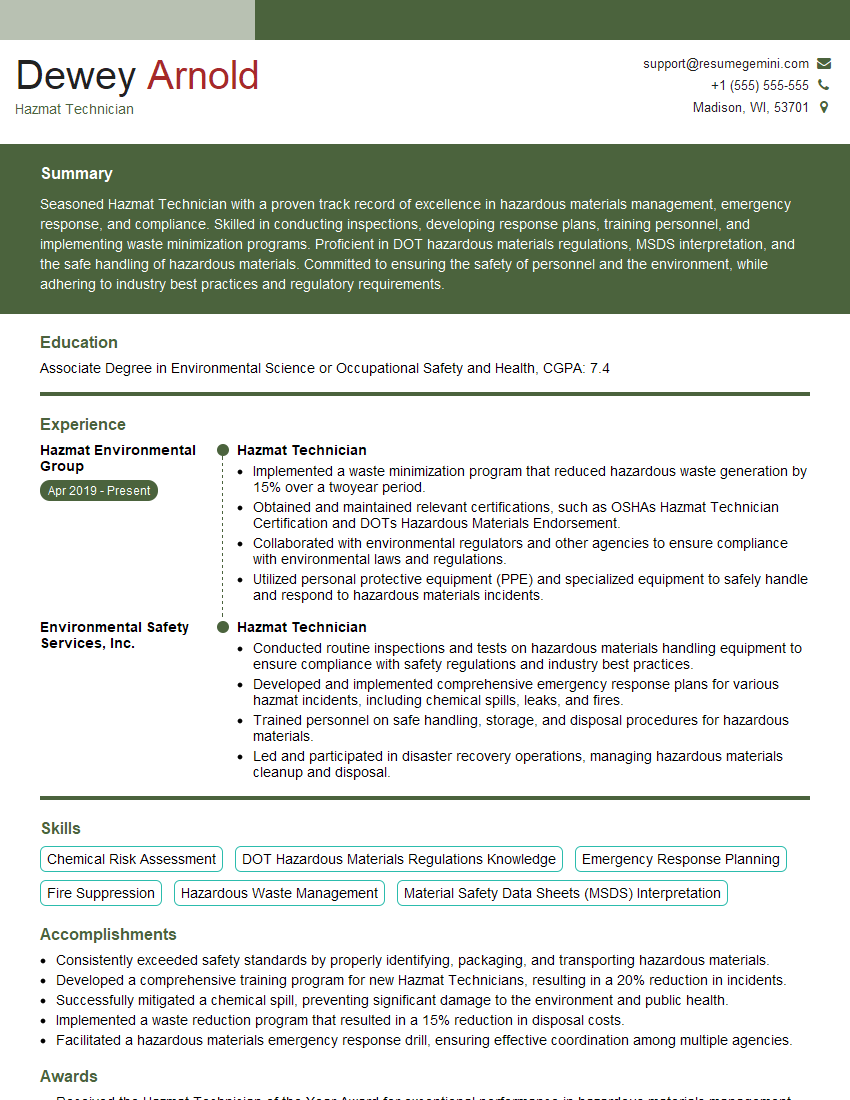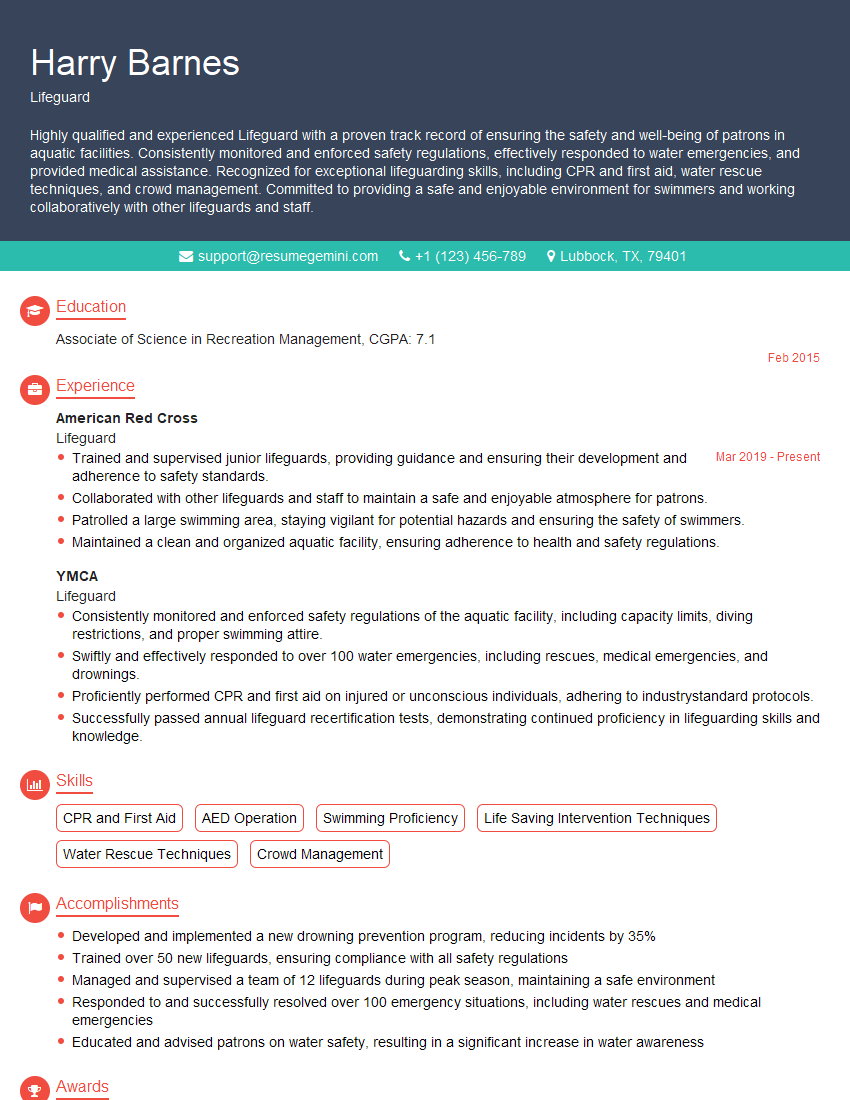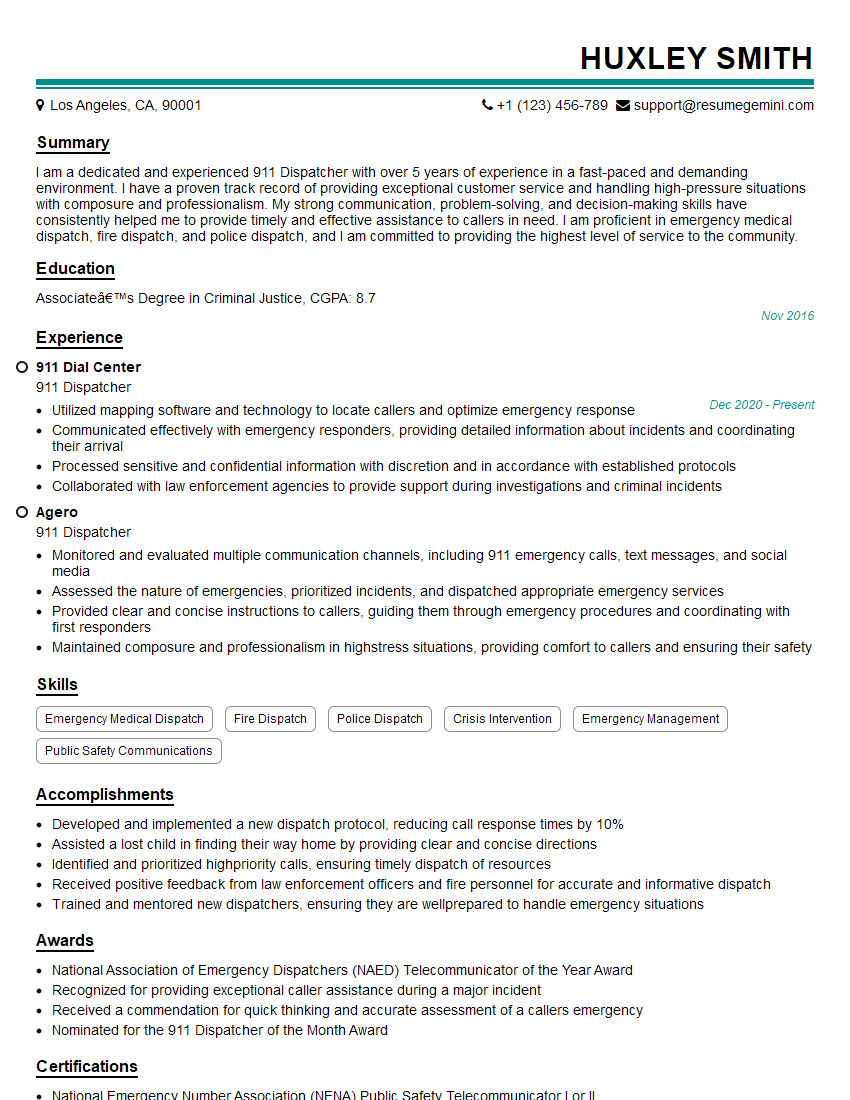Are you ready to stand out in your next interview? Understanding and preparing for Use emergency procedures interview questions is a game-changer. In this blog, we’ve compiled key questions and expert advice to help you showcase your skills with confidence and precision. Let’s get started on your journey to acing the interview.
Questions Asked in Use emergency procedures Interview
Q 1. Describe your experience with emergency response planning.
My experience with emergency response planning spans over 10 years, encompassing roles from contributing to the development of comprehensive plans to leading their execution. I’ve worked in diverse settings, including hospitals, large-scale events, and industrial facilities. This has involved everything from risk assessments and hazard identification to the creation of detailed evacuation procedures, communication protocols, and resource allocation strategies. A notable example is my work on the emergency preparedness plan for a major music festival, where we accounted for diverse risks, from natural disasters to medical emergencies and crowd control issues. The plan involved detailed mapping of evacuation routes, designated first-aid stations, and robust communication channels. We conducted multiple drills to refine the plan and train staff. This rigorous approach significantly enhanced the safety and security of the festival attendees and personnel.
Q 2. Explain the chain of command in an emergency situation.
The chain of command in an emergency is crucial for efficient and coordinated response. It typically follows a hierarchical structure, with clear lines of authority and responsibility. At the top, you have the Incident Commander, who is responsible for overall management of the response. Below the Incident Commander are various sections, such as operations, logistics, planning, and finance, each with a designated leader. Within each section, there are further levels of command, typically defined by roles and responsibilities. Think of it like a military operation, or perhaps a well-oiled machine; each part plays a crucial role, and effective communication between levels is vital. For instance, in a hospital fire, the Incident Commander might be the hospital administrator, while section leaders would oversee evacuation, firefighting efforts, and patient relocation. This structure prevents confusion and ensures that everyone knows their role and to whom they report.
Q 3. What are the key steps in a typical emergency response protocol?
A typical emergency response protocol usually follows these key steps:
- Detection and Reporting: Identifying the emergency and immediately notifying the appropriate authorities.
- Assessment and Prioritization: Evaluating the nature and severity of the situation, determining the number of casualties, and assessing the immediate risks.
- Activation of Emergency Plan: Implementing the pre-determined plan, mobilizing personnel and resources.
- Response and Control: Taking immediate action to mitigate the emergency, such as evacuating people, containing a hazardous substance, or providing first aid.
- Recovery and Post-Incident Review: Addressing immediate needs, restoring normal operations, and conducting a thorough review of the response to identify areas for improvement.
For example, a chemical spill in a factory would follow this protocol, starting with worker notification and triggering the factory’s emergency response team. The team would assess the spill’s severity, contain the substance, and evacuate affected areas. Finally, a post-incident review would analyze what went well and areas needing improvement for future events.
Q 4. How would you prioritize multiple emergencies?
Prioritizing multiple emergencies demands a systematic approach based on the severity, urgency, and potential impact of each incident. I typically use a triage system, similar to the one used in medical emergencies. This involves assessing the following factors:
- Severity: The potential for loss of life or serious injury.
- Urgency: How quickly action must be taken to prevent further harm.
- Impact: The potential consequences of the incident on the broader environment or community.
Emergencies with high severity and urgency are prioritized first, while those with lower severity or less urgency might be addressed later. Imagine a scenario where a building is on fire and a small leak is found simultaneously. The fire will undeniably take precedence due to its imminent threat to life. The leak, while needing attention, can be deferred until the fire is under control. Clear communication is crucial in this process to keep all stakeholders informed about the prioritization rationale.
Q 5. How do you ensure effective communication during an emergency?
Effective communication during an emergency is paramount. It relies on a multi-faceted approach, incorporating various methods and protocols. We utilize a combination of:
- Pre-established Communication Channels: Designated radio frequencies, dedicated phone lines, and emergency alert systems ensure reliable communication across teams.
- Clear and Concise Messaging: Messages should be brief, precise, and easily understood, avoiding jargon. Using standardized terminology minimizes misinterpretations.
- Regular Updates: Providing timely updates to all personnel and stakeholders keeps everyone informed and reduces anxiety.
- Multiple Communication Methods: Using a combination of methods, like radios, text messaging, and email, ensures that communication reaches everyone, even if one method fails.
During a hurricane, for instance, we’d use a combination of radio broadcasts, text alerts, and designated phone lines to give updates on the storm’s path, evacuation orders, and emergency shelter locations. Regular updates prevent confusion and empower residents to make informed decisions.
Q 6. Describe your experience with emergency equipment operation.
My experience with emergency equipment encompasses a wide range of tools and technologies. I am proficient in operating and maintaining equipment such as fire extinguishers, AEDs (Automated External Defibrillators), emergency radios, and various types of first-aid equipment. I’ve undergone extensive training in their proper use, safety procedures, and routine maintenance. I’m also familiar with specialized equipment, such as hazardous materials response gear and decontamination equipment. For instance, in a previous role, I was responsible for maintaining the readiness of a fleet of emergency response vehicles and ensuring that all the equipment was properly functioning and up-to-date. Regular checks and training drills are essential for ensuring quick and effective responses during critical situations.
Q 7. How do you handle stressful situations during an emergency?
Handling stressful situations during an emergency requires a combination of training, experience, and a structured approach. Maintaining composure is crucial; panic can hinder effective response. My training emphasizes the importance of:
- Deep Breathing Exercises: These help regulate breathing and heart rate, reducing feelings of anxiety.
- Prioritization and Focus: Concentrating on the immediate tasks, rather than overwhelming oneself with the entire situation.
- Teamwork and Delegation: Collaborating with the team and delegating tasks effectively reduces workload and stress.
- Post-Incident Debriefing: Processing the events and emotions through debriefing sessions helps in learning and preventing future stress.
For example, during a major accident, I focus on assessing the situation, delegating tasks to the team, and prioritizing the most critical needs – perhaps by implementing a START triage system. After the event, we conduct a debriefing to analyze our actions and identify areas for improvement in handling similar situations in the future.
Q 8. What are the common causes of workplace emergencies?
Workplace emergencies stem from a variety of sources, broadly categorized into:
- Fire and Explosion Hazards: Faulty electrical wiring, flammable materials, and improper use of equipment can lead to devastating fires or explosions.
- Chemical Spills and Leaks: Exposure to hazardous chemicals can cause severe injuries or even fatalities. This necessitates robust handling and storage procedures.
- Equipment Malfunctions: Mechanical failures in machinery can result in injuries or production disruptions, requiring immediate attention and repair.
- Natural Disasters: Earthquakes, floods, and storms can cause widespread damage and require immediate evacuation and response protocols.
- Acts of Violence: Workplace violence, whether from intruders or internal conflicts, requires immediate response and security intervention.
- Medical Emergencies: Heart attacks, strokes, or other sudden illnesses require prompt first aid and medical assistance.
Understanding these common causes helps organizations implement preventive measures and effective emergency response plans.
Q 9. How do you assess the severity of an emergency?
Assessing emergency severity is crucial for prioritizing response. I use a framework considering:
- Immediacy of threat: How quickly does the situation need to be addressed? A fire spreading rapidly needs immediate action, while a minor equipment malfunction might allow for a more controlled response.
- Number of people affected: An incident impacting many employees requires a larger scale response than one involving a single individual.
- Potential for escalation: Can the situation worsen quickly? A small chemical spill might escalate into a larger environmental hazard if not addressed immediately.
- Severity of injuries: Life-threatening injuries necessitate immediate emergency medical services.
This assessment helps determine the appropriate resources and procedures to deploy, ensuring a swift and effective response.
Q 10. Explain your experience with post-incident analysis.
Post-incident analysis is critical for continuous improvement. My approach involves:
- Fact-finding: Gathering detailed information on what happened, when, where, and how, including witness statements and any available records (e.g., security footage).
- Root cause analysis: Identifying the underlying causes of the incident, not just the immediate triggers. This often requires employing techniques like the ‘5 Whys’ to drill down to the root problem.
- Corrective actions: Developing specific and measurable steps to prevent similar incidents in the future. This could include changes to procedures, equipment upgrades, or staff training.
- Documentation: Thoroughly documenting all findings, actions, and improvements to ensure accountability and future reference.
For example, in one incident involving a near-miss with a malfunctioning machine, our post-incident analysis revealed inadequate maintenance protocols. We implemented a new preventive maintenance schedule and revised training on machine operation to address the root cause and prevent future incidents.
Q 11. What are some common mistakes made during emergencies?
Common mistakes during emergencies include:
- Panic and lack of clear communication: Confusion and ineffective communication can hinder response efforts. Clear communication protocols are essential.
- Improper use of safety equipment: Incorrect use of PPE or emergency equipment can lead to further injuries.
- Ignoring established procedures: Deviating from established emergency plans can lead to chaotic and ineffective responses.
- Failure to assess the situation accurately: Misjudging the severity of the situation can lead to inadequate or delayed responses.
- Lack of training and preparedness: Inadequate training among employees can render emergency plans ineffective. Regular drills and training are crucial.
These mistakes often stem from a lack of preparation and training. A robust emergency preparedness program mitigates these risks.
Q 12. Describe your experience with emergency evacuation procedures.
I have extensive experience conducting emergency evacuations. My approach emphasizes:
- Clear communication: Using multiple methods – alarms, announcements, and visual signals – to ensure everyone is aware of the evacuation.
- Designated assembly points: Establishing clear assembly points ensures a headcount and facilitates coordination with emergency responders.
- Evacuation routes: Clearly marked and well-maintained escape routes are essential. Staff should be familiar with multiple escape routes.
- Accountability: Designating floor wardens or team leaders to assist with evacuation and account for personnel.
- Post-evacuation procedures: Establishing procedures for accounting for everyone and communicating with emergency responders.
I’ve participated in numerous drills and real-world evacuations, always focusing on ensuring the safety and swift evacuation of all personnel.
Q 13. How would you handle a situation with an injured person?
Handling an injured person requires a calm and methodical approach. My response includes:
- Assess the situation: Determine the nature and severity of the injury, ensuring my own safety first.
- Provide first aid: Administer appropriate first aid based on my training and the nature of the injury. This might include controlling bleeding, splinting fractures, or administering CPR if needed.
- Call for medical help: Contact emergency medical services (EMS) immediately, providing clear and concise information about the location, nature of the injury, and the injured person’s condition.
- Maintain a safe environment: Protect the injured person from further harm and secure the scene.
- Cooperate with EMS: Provide necessary information and assist EMS personnel in providing care.
It’s critical to remain calm, prioritize the injured person’s well-being, and follow established protocols for medical emergencies.
Q 14. What safety measures do you typically implement?
Safety measures I regularly implement include:
- Risk assessments: Conducting regular risk assessments to identify potential hazards and implement preventive measures.
- Safety training: Providing comprehensive safety training to all employees on emergency procedures, hazard awareness, and the use of safety equipment.
- Emergency drills: Conducting regular fire drills and other emergency drills to ensure familiarity and preparedness.
- Proper maintenance of equipment: Ensuring that all equipment is regularly maintained and inspected to prevent malfunctions.
- Compliance with safety regulations: Adhering to all relevant safety regulations and standards.
- Personal protective equipment (PPE): Ensuring that appropriate PPE is readily available and used correctly.
A proactive and layered approach to safety ensures a safe and productive work environment.
Q 15. Explain your understanding of OSHA regulations (or relevant regulations).
My understanding of OSHA regulations, and similar workplace safety regulations, centers around their crucial role in preventing workplace injuries and fatalities. These regulations aren’t just a set of rules; they’re a framework built on risk assessment, hazard control, and employee training. They cover a wide spectrum, from hazard communication (understanding and properly labeling hazardous materials) to emergency action plans (EAPs), personal protective equipment (PPE) requirements, and reporting procedures for incidents and injuries. For instance, OSHA’s Hazard Communication Standard (HazCom) mandates that employers inform their employees about the hazards associated with the chemicals they handle, providing safety data sheets (SDS) and ensuring proper labeling. Similarly, OSHA’s emergency action plan requirements detail the steps an employer must take to ensure a safe and orderly evacuation in the event of a fire or other emergency, including the designation of emergency exits, procedures for accounting for personnel, and training employees on their roles.
Compliance isn’t just about avoiding fines; it’s about fostering a culture of safety. Understanding and implementing these regulations effectively means actively reducing risks and creating a healthier, safer work environment for everyone. My experience involves reviewing and implementing these regulations across various settings, ensuring that all procedures are compliant and effective.
Career Expert Tips:
- Ace those interviews! Prepare effectively by reviewing the Top 50 Most Common Interview Questions on ResumeGemini.
- Navigate your job search with confidence! Explore a wide range of Career Tips on ResumeGemini. Learn about common challenges and recommendations to overcome them.
- Craft the perfect resume! Master the Art of Resume Writing with ResumeGemini’s guide. Showcase your unique qualifications and achievements effectively.
- Don’t miss out on holiday savings! Build your dream resume with ResumeGemini’s ATS optimized templates.
Q 16. How do you ensure the safety of others during an emergency?
Ensuring the safety of others during an emergency hinges on a combination of preparedness, quick thinking, and effective communication. Before an emergency even strikes, it’s vital to have a well-defined emergency action plan in place and to ensure that everyone is thoroughly trained on their responsibilities. This training should include evacuation routes, assembly points, and communication protocols. During the emergency itself, my priorities are clear:
- Immediate Assessment: Quickly assess the situation, identifying the nature and extent of the emergency and the potential hazards.
- Prioritization: Prioritize the immediate needs, focusing on saving lives and preventing further harm. This might involve rescuing individuals in immediate danger or initiating first aid.
- Clear Communication: Maintain clear and calm communication. Provide concise instructions to those around me, keeping them informed and calm.
- Effective Evacuation: If evacuation is necessary, guide people to designated safety zones in a controlled and organized manner. Account for everyone to ensure no one is left behind.
- Post-Emergency Actions: Following the emergency, I’d help coordinate first aid and medical assistance as needed, and support the investigation to determine what happened and how to prevent similar incidents in the future.
For example, during a fire drill, I ensure everyone follows the established routes, accounts for all personnel, and maintains calm communication, ensuring efficient and safe evacuation.
Q 17. What is your experience with different types of emergencies (fire, flood, etc.)?
My experience encompasses various types of emergencies, each requiring a tailored approach. I’ve been involved in fire emergencies, where the focus is swift and orderly evacuation, ensuring everyone reaches the assembly point safely and accounts for all personnel. I’ve also managed situations involving flooding, where the priority becomes securing the area, relocating vulnerable individuals, and preventing further damage. Other experiences include dealing with hazardous material spills, requiring immediate containment and evacuation based on the specific material’s properties, and utilizing the appropriate PPE, adhering to the SDS guidelines.
Each scenario demands a unique strategy. For example, a fire necessitates immediate evacuation and calling emergency services, whereas a flood might involve securing valuable assets and assisting in sandbagging efforts if possible and safe. Dealing with hazardous materials necessitates specialized knowledge and training to ensure the safety of personnel and the environment.
Q 18. Describe a time you had to make a quick decision in an emergency.
During a chemical spill incident in a laboratory setting, I had to make a rapid decision. A technician accidentally knocked over a container of a corrosive chemical, resulting in a significant spill. My immediate assessment showed a potential risk to personnel and the environment. While other personnel started notifying the emergency response team, I quickly determined that the chemical was highly reactive with water, thus standard cleanup methods were not suitable.
Instead of using water, I immediately utilized the appropriate neutralizing agent, as detailed in the chemical’s safety data sheet (SDS), to contain the spill. This prevented further spread and minimized potential harm. This quick decision, informed by my knowledge of the chemical’s properties and the emergency procedures outlined in our chemical hygiene plan, effectively mitigated the immediate risks and allowed for a smoother cleanup. Post incident, we reviewed the procedure, and improvements to the storage and handling of chemicals were implemented.
Q 19. What are some key considerations when dealing with hazardous materials?
Dealing with hazardous materials demands a comprehensive approach, prioritizing safety at every stage. Key considerations include:
- Identification and Classification: Accurate identification of the hazardous material is paramount. This involves checking labels, safety data sheets (SDS), and any other available documentation to understand its properties and potential hazards (toxicity, flammability, reactivity, etc.).
- Risk Assessment: A thorough risk assessment is crucial to understand the potential dangers and determine appropriate control measures. This assessment should consider the material’s properties, the quantity involved, the location, and the potential exposure routes.
- Personal Protective Equipment (PPE): Choosing and using the right PPE is essential. This might include respirators, gloves, eye protection, and specialized suits, depending on the specific hazards.
- Containment and Cleanup: Effective containment prevents further spread of the material. Cleanup procedures must be appropriate for the material and should follow manufacturer guidelines and best practices to avoid secondary contamination.
- Emergency Response: Having a clear emergency response plan is critical. This should include procedures for contacting emergency services, evacuating personnel, and using appropriate spill control equipment.
Failure to properly handle hazardous materials can lead to serious injuries, environmental damage, and significant financial consequences. Strict adherence to regulations and procedures is non-negotiable.
Q 20. How do you maintain updated knowledge of emergency procedures?
Maintaining updated knowledge of emergency procedures is an ongoing process that requires active participation. I utilize several strategies:
- Regular Training and Drills: Participating in regular training sessions and drills keeps my skills sharp and ensures I’m familiar with the latest procedures and equipment. These drills cover scenarios ranging from fire evacuations to hazardous material spills.
- Review of Safety Data Sheets (SDS): Regularly reviewing SDS for all chemicals and materials in the workplace ensures awareness of their hazards and safe handling practices.
- Professional Development: Staying current with industry best practices and changes in regulations through professional development courses and attending relevant workshops helps maintain updated knowledge.
- Following Industry News and Updates: I actively monitor safety publications, newsletters, and online resources to stay abreast of new techniques and technologies in emergency response.
- Internal Communication: Open communication and regular updates within my team help share valuable knowledge and ensure that everyone is on the same page regarding procedures.
Keeping up-to-date is not a passive activity; it’s an active commitment to safety, ensuring that I can effectively handle any emergency that may arise.
Q 21. How would you train others on emergency procedures?
Training others on emergency procedures involves a multi-faceted approach that goes beyond simply presenting information. My training methodology focuses on engagement and practical application:
- Needs Assessment: I begin by assessing the trainees’ existing knowledge and identifying their specific training needs. This ensures the training is tailored to their level of understanding.
- Interactive Sessions: I utilize interactive methods, such as discussions, group exercises, and simulations, to foster active learning and engagement. This makes the training more memorable and impactful.
- Hands-on Practice: Practical demonstrations and hands-on drills are crucial for reinforcing learned skills. This allows trainees to experience real-world scenarios in a safe and controlled environment.
- Scenario-Based Training: Training should incorporate a variety of realistic emergency scenarios, allowing trainees to practice their responses in different situations. This helps develop problem-solving skills under pressure.
- Regular Assessments and Feedback: Regular quizzes, tests, and feedback sessions help gauge understanding and identify areas where additional instruction might be needed.
- Documentation and Record Keeping: Maintaining detailed records of training sessions and participant performance is crucial for demonstrating compliance and evaluating the effectiveness of the training program.
Effective training isn’t a one-time event; it’s an ongoing process to ensure everyone is well-prepared and confident in handling emergencies.
Q 22. How do you adapt emergency procedures to different situations?
Adapting emergency procedures hinges on understanding the unique circumstances of each situation. A standardized procedure is a great starting point, but flexibility is key. We need to consider the specific type of emergency (fire, medical, security breach, etc.), the location, the number of people involved, and the available resources.
- Example: A fire in a small office building will necessitate a different evacuation plan compared to a high-rise. The former might involve a simple direct exit, while the latter may require multiple stairwells and designated assembly points.
- Example: A medical emergency involving a heart attack will require immediate access to a defibrillator and emergency medical services, unlike a minor injury that may only require first aid.
- Process: My approach begins with a quick assessment of the situation. I identify the immediate dangers and priorities. Then, I adapt existing procedures to match. This may involve assigning roles differently, prioritizing certain actions, or even improvising based on the available resources. Documentation of this adaptation is crucial for future improvements.
Q 23. Describe your experience with crisis communication.
Crisis communication is the backbone of effective emergency response. My experience encompasses a wide range of situations, from informing employees about a power outage to coordinating responses during a major incident. Clear, concise, and timely communication is paramount.
- Channels: I utilize various communication methods, including email, text alerts, public address systems, and even social media, depending on the situation and the audience. The goal is to reach everyone affected quickly and effectively.
- Message Consistency: Maintaining a consistent message is crucial to avoid confusion and panic. All communication channels should relay the same information. Inaccurate or contradictory information can exacerbate a crisis.
- Example: During a severe weather event, I would use text alerts to inform employees of building closures and provide instructions for safe travel. I would also update our company website and social media accounts with the same information to keep everyone informed.
- Transparency and Empathy: Acknowledging the uncertainty and anxiety during a crisis and offering support is essential. Being open and honest—even if bad news needs to be conveyed—builds trust and strengthens community resilience.
Q 24. What are the legal implications of workplace accidents?
Workplace accidents have significant legal implications, encompassing both civil and criminal liability. Employers have a legal duty of care to provide a safe working environment. Failure to do so can lead to substantial fines, lawsuits, and even criminal charges.
- Occupational Safety and Health Administration (OSHA): In many jurisdictions, organizations are subject to OSHA regulations or similar standards which outline requirements for safety procedures. Violations can result in serious penalties.
- Workers’ Compensation: Employees injured on the job are typically entitled to workers’ compensation benefits, including medical expenses and lost wages. The employer’s insurance usually covers these costs, but failure to comply with reporting requirements can lead to legal action.
- Civil Lawsuits: Injured workers can also sue their employers for negligence, claiming that the employer’s actions or inaction led to the accident. Such lawsuits can result in significant financial damages for the employer.
- Criminal Charges: In cases involving gross negligence, recklessness, or intentional wrongdoing, criminal charges may be filed against the employer or responsible individuals. This might involve manslaughter or other serious offenses.
Properly documenting accidents, conducting thorough investigations, implementing corrective actions, and maintaining comprehensive safety programs are vital steps in mitigating legal risks.
Q 25. How do you document emergency incidents?
Accurate and thorough documentation is crucial for various reasons, from investigating the cause of an incident to complying with legal and regulatory requirements. My documentation process follows a structured approach.
- Incident Report Form: A standardized form is used to record details such as date, time, location, nature of the incident, individuals involved, witnesses, and initial observations.
- Photographs and Videos: Visual evidence is crucial. Photos and videos of the scene, injuries, and damaged equipment are captured as soon as it’s safe to do so.
- Witness Statements: Statements from all witnesses are collected, providing diverse perspectives on the events.
- Medical Records: If injuries occur, medical records are obtained to document the extent of injuries and treatment received.
- Corrective Actions: Following the investigation, the report outlines the identified root cause(s) and actions taken to prevent recurrence. This often includes safety improvements or updated procedures.
All documentation is securely stored according to organizational protocols, ensuring confidentiality and accessibility when needed. The goal is to create a complete and unbiased record of the incident for review and analysis.
Q 26. What is your understanding of risk assessment?
Risk assessment is a systematic process of identifying hazards, analyzing their potential risks, and developing strategies to mitigate those risks. It’s a proactive approach that aims to prevent incidents before they occur.
- Hazard Identification: This step involves systematically identifying all potential hazards within a workplace or operation. This can include physical hazards (e.g., machinery, chemicals), ergonomic hazards (e.g., repetitive movements, awkward postures), and psychosocial hazards (e.g., stress, harassment).
- Risk Analysis: Once hazards are identified, their likelihood and severity are assessed. This often involves a qualitative or quantitative analysis to determine the level of risk associated with each hazard.
- Risk Control: Based on the risk analysis, appropriate control measures are implemented to reduce or eliminate the risks. This might involve using personal protective equipment (PPE), modifying work processes, providing training, or engineering controls.
- Monitoring and Review: The effectiveness of the risk control measures is regularly monitored and reviewed to ensure they remain effective. The risk assessment should be updated as needed based on changes in the workplace or operations.
A well-conducted risk assessment provides a framework for proactive safety management, reducing the likelihood of accidents and injuries.
Q 27. How do you use technology to support emergency procedures?
Technology plays a vital role in supporting emergency procedures, enhancing efficiency and effectiveness. Several technologies are integral to my approach.
- Emergency Alert Systems: These systems enable rapid dissemination of alerts and instructions to employees during emergencies. This can include mass notification systems using SMS, email, and other digital channels.
- Building Management Systems (BMS): BMS systems can automate responses to certain emergencies, such as triggering fire alarms, locking down areas, and controlling HVAC systems.
- GPS Tracking and Location Services: For large facilities, real-time tracking of personnel can improve evacuation management and response time during emergencies.
- Data Analytics and Reporting: Data from various sources can be analyzed to identify trends and patterns in incidents, allowing for proactive risk management and improved procedures.
- Incident Management Software: Dedicated software helps manage and track incidents, streamlining documentation, investigation, and reporting processes.
The key is selecting and integrating technologies appropriate for the specific needs of the organization and the types of emergencies anticipated.
Q 28. How do you ensure compliance with relevant emergency regulations?
Ensuring compliance with emergency regulations requires a multi-faceted approach. It’s not a one-time event but an ongoing process.
- Regular Audits and Inspections: Conducting regular internal audits and inspections to ensure that procedures and equipment meet regulatory standards. This helps identify any deficiencies early on.
- Training and Education: Providing comprehensive training to all employees on emergency procedures, including evacuation plans, first aid, and use of safety equipment. Regular refresher training reinforces compliance.
- Documentation and Record Keeping: Maintaining detailed records of all emergency-related activities, including training, inspections, and incident reports. This documentation is crucial for demonstrating compliance to regulatory bodies.
- Staying Updated on Regulations: Staying current with changes in relevant legislation and regulations to ensure procedures and practices remain compliant. This often requires subscribing to relevant newsletters or attending industry events.
- Collaboration with Regulatory Bodies: Collaborating with relevant regulatory bodies to ensure compliance and address any questions or concerns they may have.
Compliance is not just about avoiding penalties; it’s about creating a safer working environment and protecting the well-being of everyone involved.
Key Topics to Learn for Use emergency procedures Interview
- Emergency Response Protocols: Understanding various emergency protocols (fire, medical, security) and their implementation.
- Risk Assessment and Mitigation: Identifying potential hazards and implementing preventative measures to minimize risks.
- Emergency Communication Systems: Familiarity with different communication tools and procedures for effective information dissemination during emergencies.
- Evacuation Procedures: Knowledge of safe evacuation routes, assembly points, and accountability procedures.
- First Aid and CPR: Understanding basic first aid and CPR techniques and their application in emergency situations (depending on the role’s requirements).
- Incident Reporting and Documentation: Proper procedures for reporting incidents, documenting actions taken, and following up.
- Post-Incident Analysis and Improvement: Participating in reviews to identify areas for improvement in emergency response procedures.
- Legal and Regulatory Compliance: Awareness of relevant laws and regulations concerning emergency procedures and workplace safety.
- Teamwork and Collaboration: Demonstrating effective teamwork and communication skills during emergency response drills and actual emergencies.
- Stress Management and Decision-Making under Pressure: Developing strategies for managing stress and making sound judgments in high-pressure situations.
Next Steps
Mastering emergency procedures demonstrates crucial skills highly valued by employers – problem-solving, quick thinking, and a commitment to safety. This expertise significantly enhances your career prospects across various industries. To increase your chances of landing your dream job, focus on creating an ATS-friendly resume that showcases these abilities effectively. ResumeGemini is a trusted resource that can help you build a professional and impactful resume. We provide examples of resumes tailored to Use emergency procedures roles to guide you in crafting a winning application.
Explore more articles
Users Rating of Our Blogs
Share Your Experience
We value your feedback! Please rate our content and share your thoughts (optional).
What Readers Say About Our Blog
Hi, I’m Jay, we have a few potential clients that are interested in your services, thought you might be a good fit. I’d love to talk about the details, when do you have time to talk?
Best,
Jay
Founder | CEO
